Crime Reduction and Community Safety: Strategies, Impact, and Analysis
VerifiedAdded on 2022/12/27
|10
|3126
|44
Report
AI Summary
This report provides a comprehensive analysis of crime reduction and community safety, focusing on crime statistics in England and Wales up to June 2020. It examines the methods used by police to record crime and compares them with the Crime Survey for England & Wales (CSEW), evaluating the strengths and weaknesses of each approach. The report delves into the impact of crime on victims and communities, considering both short-term and long-term consequences, and explores the philosophy of community policing, including associated legislation. Furthermore, it outlines the roles and responsibilities of various public services and related agencies in addressing crime and disorder. The report concludes by reviewing the effectiveness of different crime reduction strategies, identifying the key factors that underpin these strategies, such as personal safety, excess control, and situational crime prevention techniques, providing a well-rounded overview of the challenges and approaches in this critical area.
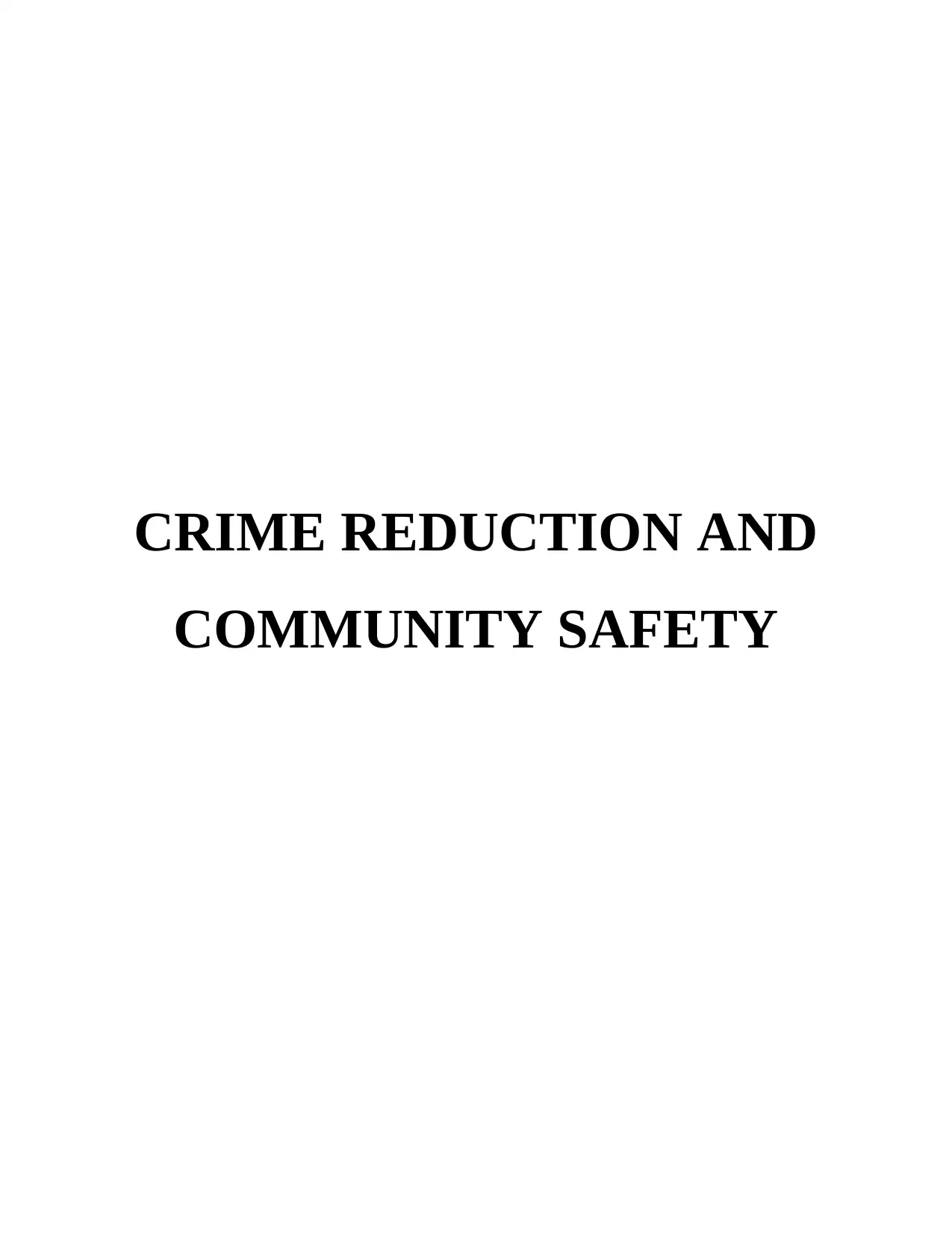
CRIME REDUCTION AND
COMMUNITY SAFETY
COMMUNITY SAFETY
Paraphrase This Document
Need a fresh take? Get an instant paraphrase of this document with our AI Paraphraser

TABLE OF CONTENTS
INTRODUCTION...........................................................................................................................1
SECTION 1.....................................................................................................................................1
SECTION 2.....................................................................................................................................3
Section-3: Effectiveness of Crime Reduction Strategies.................................................................5
CONCLUSION................................................................................................................................7
REFERENCES................................................................................................................................8
INTRODUCTION...........................................................................................................................1
SECTION 1.....................................................................................................................................1
SECTION 2.....................................................................................................................................3
Section-3: Effectiveness of Crime Reduction Strategies.................................................................5
CONCLUSION................................................................................................................................7
REFERENCES................................................................................................................................8
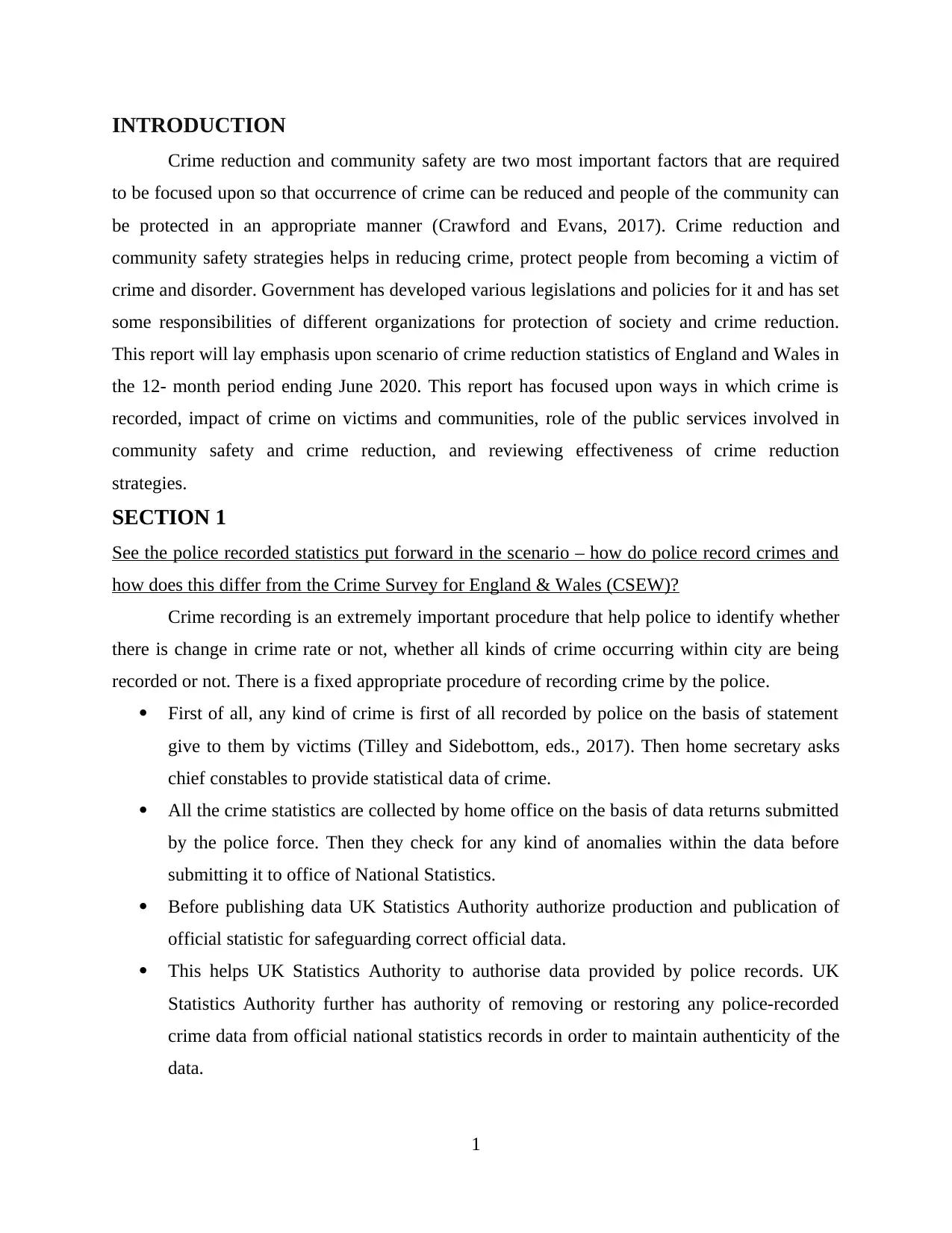
INTRODUCTION
Crime reduction and community safety are two most important factors that are required
to be focused upon so that occurrence of crime can be reduced and people of the community can
be protected in an appropriate manner (Crawford and Evans, 2017). Crime reduction and
community safety strategies helps in reducing crime, protect people from becoming a victim of
crime and disorder. Government has developed various legislations and policies for it and has set
some responsibilities of different organizations for protection of society and crime reduction.
This report will lay emphasis upon scenario of crime reduction statistics of England and Wales in
the 12- month period ending June 2020. This report has focused upon ways in which crime is
recorded, impact of crime on victims and communities, role of the public services involved in
community safety and crime reduction, and reviewing effectiveness of crime reduction
strategies.
SECTION 1
See the police recorded statistics put forward in the scenario – how do police record crimes and
how does this differ from the Crime Survey for England & Wales (CSEW)?
Crime recording is an extremely important procedure that help police to identify whether
there is change in crime rate or not, whether all kinds of crime occurring within city are being
recorded or not. There is a fixed appropriate procedure of recording crime by the police.
First of all, any kind of crime is first of all recorded by police on the basis of statement
give to them by victims (Tilley and Sidebottom, eds., 2017). Then home secretary asks
chief constables to provide statistical data of crime.
All the crime statistics are collected by home office on the basis of data returns submitted
by the police force. Then they check for any kind of anomalies within the data before
submitting it to office of National Statistics.
Before publishing data UK Statistics Authority authorize production and publication of
official statistic for safeguarding correct official data.
This helps UK Statistics Authority to authorise data provided by police records. UK
Statistics Authority further has authority of removing or restoring any police-recorded
crime data from official national statistics records in order to maintain authenticity of the
data.
1
Crime reduction and community safety are two most important factors that are required
to be focused upon so that occurrence of crime can be reduced and people of the community can
be protected in an appropriate manner (Crawford and Evans, 2017). Crime reduction and
community safety strategies helps in reducing crime, protect people from becoming a victim of
crime and disorder. Government has developed various legislations and policies for it and has set
some responsibilities of different organizations for protection of society and crime reduction.
This report will lay emphasis upon scenario of crime reduction statistics of England and Wales in
the 12- month period ending June 2020. This report has focused upon ways in which crime is
recorded, impact of crime on victims and communities, role of the public services involved in
community safety and crime reduction, and reviewing effectiveness of crime reduction
strategies.
SECTION 1
See the police recorded statistics put forward in the scenario – how do police record crimes and
how does this differ from the Crime Survey for England & Wales (CSEW)?
Crime recording is an extremely important procedure that help police to identify whether
there is change in crime rate or not, whether all kinds of crime occurring within city are being
recorded or not. There is a fixed appropriate procedure of recording crime by the police.
First of all, any kind of crime is first of all recorded by police on the basis of statement
give to them by victims (Tilley and Sidebottom, eds., 2017). Then home secretary asks
chief constables to provide statistical data of crime.
All the crime statistics are collected by home office on the basis of data returns submitted
by the police force. Then they check for any kind of anomalies within the data before
submitting it to office of National Statistics.
Before publishing data UK Statistics Authority authorize production and publication of
official statistic for safeguarding correct official data.
This helps UK Statistics Authority to authorise data provided by police records. UK
Statistics Authority further has authority of removing or restoring any police-recorded
crime data from official national statistics records in order to maintain authenticity of the
data.
1
⊘ This is a preview!⊘
Do you want full access?
Subscribe today to unlock all pages.

Trusted by 1+ million students worldwide
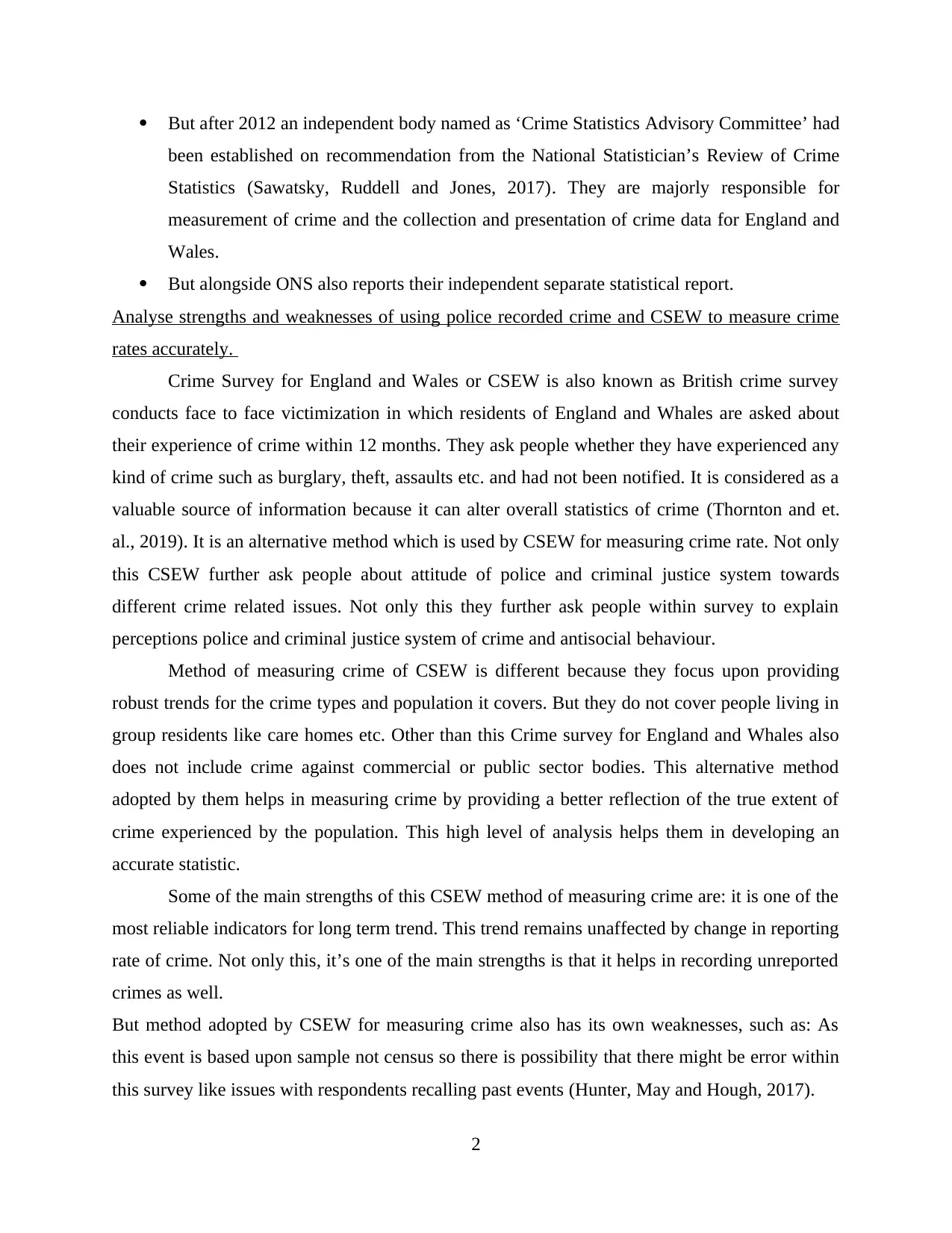
But after 2012 an independent body named as ‘Crime Statistics Advisory Committee’ had
been established on recommendation from the National Statistician’s Review of Crime
Statistics (Sawatsky, Ruddell and Jones, 2017). They are majorly responsible for
measurement of crime and the collection and presentation of crime data for England and
Wales.
But alongside ONS also reports their independent separate statistical report.
Analyse strengths and weaknesses of using police recorded crime and CSEW to measure crime
rates accurately.
Crime Survey for England and Wales or CSEW is also known as British crime survey
conducts face to face victimization in which residents of England and Whales are asked about
their experience of crime within 12 months. They ask people whether they have experienced any
kind of crime such as burglary, theft, assaults etc. and had not been notified. It is considered as a
valuable source of information because it can alter overall statistics of crime (Thornton and et.
al., 2019). It is an alternative method which is used by CSEW for measuring crime rate. Not only
this CSEW further ask people about attitude of police and criminal justice system towards
different crime related issues. Not only this they further ask people within survey to explain
perceptions police and criminal justice system of crime and antisocial behaviour.
Method of measuring crime of CSEW is different because they focus upon providing
robust trends for the crime types and population it covers. But they do not cover people living in
group residents like care homes etc. Other than this Crime survey for England and Whales also
does not include crime against commercial or public sector bodies. This alternative method
adopted by them helps in measuring crime by providing a better reflection of the true extent of
crime experienced by the population. This high level of analysis helps them in developing an
accurate statistic.
Some of the main strengths of this CSEW method of measuring crime are: it is one of the
most reliable indicators for long term trend. This trend remains unaffected by change in reporting
rate of crime. Not only this, it’s one of the main strengths is that it helps in recording unreported
crimes as well.
But method adopted by CSEW for measuring crime also has its own weaknesses, such as: As
this event is based upon sample not census so there is possibility that there might be error within
this survey like issues with respondents recalling past events (Hunter, May and Hough, 2017).
2
been established on recommendation from the National Statistician’s Review of Crime
Statistics (Sawatsky, Ruddell and Jones, 2017). They are majorly responsible for
measurement of crime and the collection and presentation of crime data for England and
Wales.
But alongside ONS also reports their independent separate statistical report.
Analyse strengths and weaknesses of using police recorded crime and CSEW to measure crime
rates accurately.
Crime Survey for England and Wales or CSEW is also known as British crime survey
conducts face to face victimization in which residents of England and Whales are asked about
their experience of crime within 12 months. They ask people whether they have experienced any
kind of crime such as burglary, theft, assaults etc. and had not been notified. It is considered as a
valuable source of information because it can alter overall statistics of crime (Thornton and et.
al., 2019). It is an alternative method which is used by CSEW for measuring crime rate. Not only
this CSEW further ask people about attitude of police and criminal justice system towards
different crime related issues. Not only this they further ask people within survey to explain
perceptions police and criminal justice system of crime and antisocial behaviour.
Method of measuring crime of CSEW is different because they focus upon providing
robust trends for the crime types and population it covers. But they do not cover people living in
group residents like care homes etc. Other than this Crime survey for England and Whales also
does not include crime against commercial or public sector bodies. This alternative method
adopted by them helps in measuring crime by providing a better reflection of the true extent of
crime experienced by the population. This high level of analysis helps them in developing an
accurate statistic.
Some of the main strengths of this CSEW method of measuring crime are: it is one of the
most reliable indicators for long term trend. This trend remains unaffected by change in reporting
rate of crime. Not only this, it’s one of the main strengths is that it helps in recording unreported
crimes as well.
But method adopted by CSEW for measuring crime also has its own weaknesses, such as: As
this event is based upon sample not census so there is possibility that there might be error within
this survey like issues with respondents recalling past events (Hunter, May and Hough, 2017).
2
Paraphrase This Document
Need a fresh take? Get an instant paraphrase of this document with our AI Paraphraser
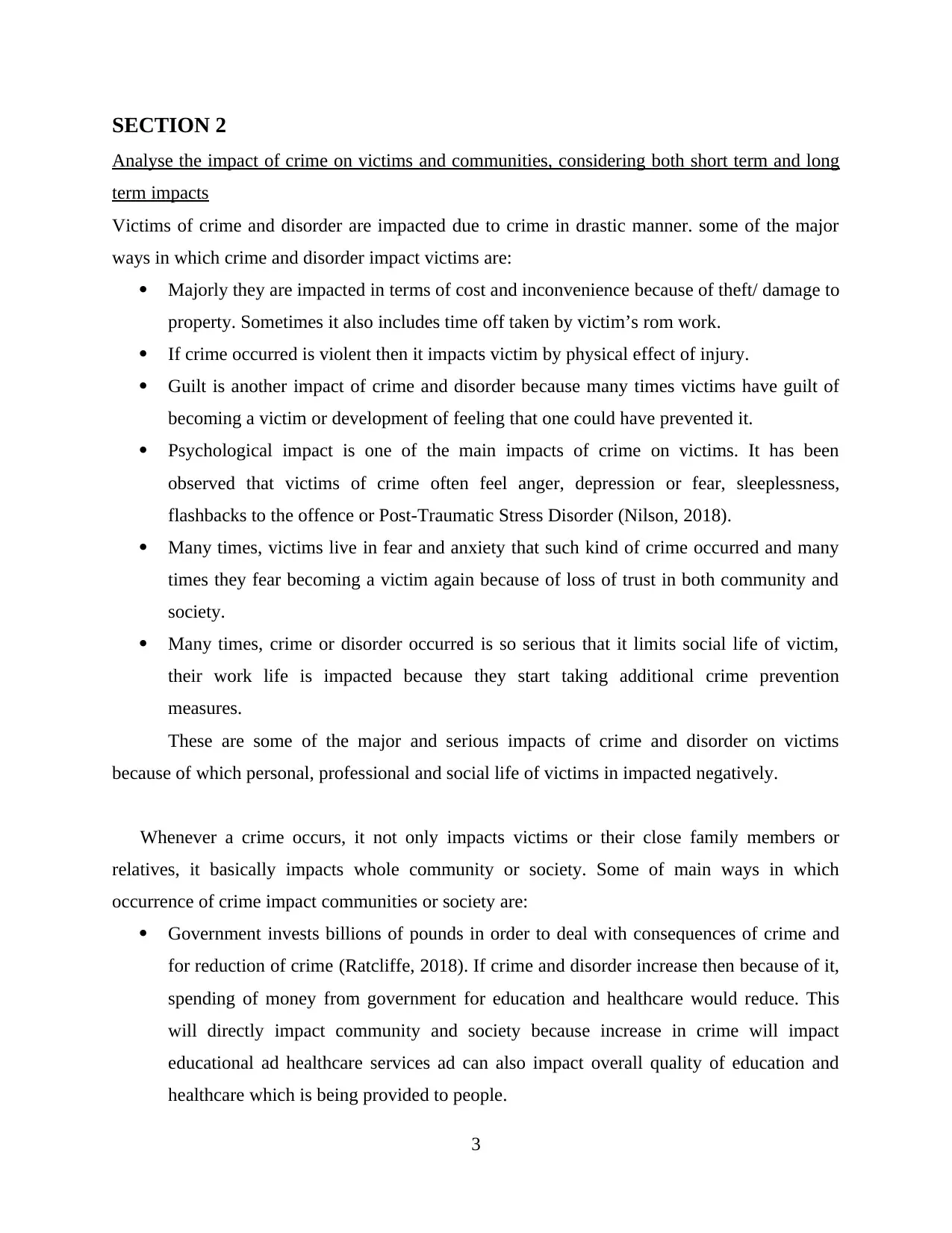
SECTION 2
Analyse the impact of crime on victims and communities, considering both short term and long
term impacts
Victims of crime and disorder are impacted due to crime in drastic manner. some of the major
ways in which crime and disorder impact victims are:
Majorly they are impacted in terms of cost and inconvenience because of theft/ damage to
property. Sometimes it also includes time off taken by victim’s rom work.
If crime occurred is violent then it impacts victim by physical effect of injury.
Guilt is another impact of crime and disorder because many times victims have guilt of
becoming a victim or development of feeling that one could have prevented it.
Psychological impact is one of the main impacts of crime on victims. It has been
observed that victims of crime often feel anger, depression or fear, sleeplessness,
flashbacks to the offence or Post-Traumatic Stress Disorder (Nilson, 2018).
Many times, victims live in fear and anxiety that such kind of crime occurred and many
times they fear becoming a victim again because of loss of trust in both community and
society.
Many times, crime or disorder occurred is so serious that it limits social life of victim,
their work life is impacted because they start taking additional crime prevention
measures.
These are some of the major and serious impacts of crime and disorder on victims
because of which personal, professional and social life of victims in impacted negatively.
Whenever a crime occurs, it not only impacts victims or their close family members or
relatives, it basically impacts whole community or society. Some of main ways in which
occurrence of crime impact communities or society are:
Government invests billions of pounds in order to deal with consequences of crime and
for reduction of crime (Ratcliffe, 2018). If crime and disorder increase then because of it,
spending of money from government for education and healthcare would reduce. This
will directly impact community and society because increase in crime will impact
educational ad healthcare services ad can also impact overall quality of education and
healthcare which is being provided to people.
3
Analyse the impact of crime on victims and communities, considering both short term and long
term impacts
Victims of crime and disorder are impacted due to crime in drastic manner. some of the major
ways in which crime and disorder impact victims are:
Majorly they are impacted in terms of cost and inconvenience because of theft/ damage to
property. Sometimes it also includes time off taken by victim’s rom work.
If crime occurred is violent then it impacts victim by physical effect of injury.
Guilt is another impact of crime and disorder because many times victims have guilt of
becoming a victim or development of feeling that one could have prevented it.
Psychological impact is one of the main impacts of crime on victims. It has been
observed that victims of crime often feel anger, depression or fear, sleeplessness,
flashbacks to the offence or Post-Traumatic Stress Disorder (Nilson, 2018).
Many times, victims live in fear and anxiety that such kind of crime occurred and many
times they fear becoming a victim again because of loss of trust in both community and
society.
Many times, crime or disorder occurred is so serious that it limits social life of victim,
their work life is impacted because they start taking additional crime prevention
measures.
These are some of the major and serious impacts of crime and disorder on victims
because of which personal, professional and social life of victims in impacted negatively.
Whenever a crime occurs, it not only impacts victims or their close family members or
relatives, it basically impacts whole community or society. Some of main ways in which
occurrence of crime impact communities or society are:
Government invests billions of pounds in order to deal with consequences of crime and
for reduction of crime (Ratcliffe, 2018). If crime and disorder increase then because of it,
spending of money from government for education and healthcare would reduce. This
will directly impact community and society because increase in crime will impact
educational ad healthcare services ad can also impact overall quality of education and
healthcare which is being provided to people.
3

Increase in crime and disorder can also impact house prices, neighbourhood satisfaction
or desire of people to move to a safe neighbourhood. This is majorly because if crime
within a neighbourhood increases then it will impact satisfaction of people living in that
neighbourhood, many times due to increasing crime prices of houses near crime place
decreases drastically and people do not tend to move in that neighbourhood as well
(Ratcliffe, 2018).
Increasing crime and disorder also impact perception of people living in the community
or it can also be said that mentality of open mindedness of people also get impacted. trust
among community people also reduces due to crime and disorder.
Explain the philosophy of community policing and associated legislation
There are various kinds of legislations and policies that helps in setting responsibilities of
organizations in terms of crime reduction. There is a community policy that has been developed
and set in order to reduce crime. It is a collaboration between police and community. These
legislations and community policies help in providing a support to police so that they can guard
or prevent community from any kind of crime and disorder.
Legislation has set roles and responsibilities of police so that they can focus upon
tackling crime and work upon reducing crime rate. Another responsibility that legislation of UK
sets for police is to protect victims of crime and ensure that same crime does not occur again.
Legislation of UK has further set instruction for television or radio organizations (Ratcliffe,
2018). Tv and radio stations can broadcast crime occurring within the city in order to increase
awareness of people about different kinds of crime occurring within city or country so that
people can remain aware of their surroundings. But all kinds of instructions given to them by
court or police about broadcasting of any kind of crime is required to be followed by them. These
roles and responsibilities of different organizations are based upon community policies so that
effective relationship between police and society can be maintained. One of the main factor
because of which these community policies are developed is to develop trust among community
people or residents of country within police and other organizations who are working for safety
of people.
Explanation of role and responsibilities of a range of public services and related agencies in
addressing crime and disorder
4
or desire of people to move to a safe neighbourhood. This is majorly because if crime
within a neighbourhood increases then it will impact satisfaction of people living in that
neighbourhood, many times due to increasing crime prices of houses near crime place
decreases drastically and people do not tend to move in that neighbourhood as well
(Ratcliffe, 2018).
Increasing crime and disorder also impact perception of people living in the community
or it can also be said that mentality of open mindedness of people also get impacted. trust
among community people also reduces due to crime and disorder.
Explain the philosophy of community policing and associated legislation
There are various kinds of legislations and policies that helps in setting responsibilities of
organizations in terms of crime reduction. There is a community policy that has been developed
and set in order to reduce crime. It is a collaboration between police and community. These
legislations and community policies help in providing a support to police so that they can guard
or prevent community from any kind of crime and disorder.
Legislation has set roles and responsibilities of police so that they can focus upon
tackling crime and work upon reducing crime rate. Another responsibility that legislation of UK
sets for police is to protect victims of crime and ensure that same crime does not occur again.
Legislation of UK has further set instruction for television or radio organizations (Ratcliffe,
2018). Tv and radio stations can broadcast crime occurring within the city in order to increase
awareness of people about different kinds of crime occurring within city or country so that
people can remain aware of their surroundings. But all kinds of instructions given to them by
court or police about broadcasting of any kind of crime is required to be followed by them. These
roles and responsibilities of different organizations are based upon community policies so that
effective relationship between police and society can be maintained. One of the main factor
because of which these community policies are developed is to develop trust among community
people or residents of country within police and other organizations who are working for safety
of people.
Explanation of role and responsibilities of a range of public services and related agencies in
addressing crime and disorder
4
⊘ This is a preview!⊘
Do you want full access?
Subscribe today to unlock all pages.

Trusted by 1+ million students worldwide

Public services and related agencies plays an important role in terms of addressing crime
and related disorders. Since there are various public services including police, local authority,
social services exist in the society so the very first role is being lied to them in terms of
prevention and occurrence of crime. This means that if the local authority or the police of the
area will be careful and ware then the local crimes will never going to be occurred. In addition,
of prevention and occurrence of crime they also play an important role in terms of providing help
and assistance to victim apart from capturing the criminal. Since crime is categorized as a serious
offence so it also emerges legal and statutory responsibility towards the police and legal
authority in terms of protecting the victim and enabling punishment to offender.
As the public is wholly dependent upon the police and local authorities so in this case the
roles and responsibilities of public service and related agencies raises (Freilich and Newman,
2017). This means that they have to adopt every possible step by which they can prevent the
occurrence of crime along with catching the criminal in short time if the crime occurs. Thus, the
local agencies and police by partnering with each other can plays an important role and deliver
their responsibilities. This means that they can perform their role in the form of setting and
establishing adequate tactics in the society or the locality which could either be executed in the
form of setting up of cctv cameras or the police patrolling can help in preventing the occurrence
of any crime. However apart from this roles if in case any crime or incident occurs they can
deliver their responsibility in the form of helping the victim or taking as efficient action that
could catch the offender in minimum possible time which can be done through viewing the cctv
footage or the taking evidences from the crime location.
Section-3: Effectiveness of Crime Reduction Strategies
Factors that underpin crime reduction strategies
There are several factors on which crime reduction strategies are based. Out of them some are:
Personal safety:
This is the basic factor over which crime reduction strategy can be base. This means that
these strategies cover every possible aspect by which personal safety can be ensured to an
individual. These strategies are designed in such a manner that an individual can feel safe and
secure in its home.
Excess control:
5
and related disorders. Since there are various public services including police, local authority,
social services exist in the society so the very first role is being lied to them in terms of
prevention and occurrence of crime. This means that if the local authority or the police of the
area will be careful and ware then the local crimes will never going to be occurred. In addition,
of prevention and occurrence of crime they also play an important role in terms of providing help
and assistance to victim apart from capturing the criminal. Since crime is categorized as a serious
offence so it also emerges legal and statutory responsibility towards the police and legal
authority in terms of protecting the victim and enabling punishment to offender.
As the public is wholly dependent upon the police and local authorities so in this case the
roles and responsibilities of public service and related agencies raises (Freilich and Newman,
2017). This means that they have to adopt every possible step by which they can prevent the
occurrence of crime along with catching the criminal in short time if the crime occurs. Thus, the
local agencies and police by partnering with each other can plays an important role and deliver
their responsibilities. This means that they can perform their role in the form of setting and
establishing adequate tactics in the society or the locality which could either be executed in the
form of setting up of cctv cameras or the police patrolling can help in preventing the occurrence
of any crime. However apart from this roles if in case any crime or incident occurs they can
deliver their responsibility in the form of helping the victim or taking as efficient action that
could catch the offender in minimum possible time which can be done through viewing the cctv
footage or the taking evidences from the crime location.
Section-3: Effectiveness of Crime Reduction Strategies
Factors that underpin crime reduction strategies
There are several factors on which crime reduction strategies are based. Out of them some are:
Personal safety:
This is the basic factor over which crime reduction strategy can be base. This means that
these strategies cover every possible aspect by which personal safety can be ensured to an
individual. These strategies are designed in such a manner that an individual can feel safe and
secure in its home.
Excess control:
5
Paraphrase This Document
Need a fresh take? Get an instant paraphrase of this document with our AI Paraphraser

Excess control also become an important base in terms of designing crime reduction
strategies. This can be implemented in the form of installation of cctv cameras in the public
places, assigning guards, making access difficulty by lying a system of checking id proofs and
legal documents.
Surveillance:
It is also a major base of crime reduction strategies. This means that if there will be tight
surveillance in terms of continuous and keen watch over every wrong and unusual activity then
this will lead as a base by which crime will not occur (Munyo and Rossi, 2020).
Rules:
These are the major base over which the crime reduction strategies are formulated. This
means that if there are certain clear set of strict rules in terms of protecting the victim and
punishing the criminal then crime will automatically reduce and their intensity will decline.
Description of range of local and national strategies used to tackle crime and disorder
In order to prevent crime at initial level local strategies plays an important role. There are
various strategies that can be adopted at local level in order to prevent crime. Out of them some
may include:
Prevention of crime through social awareness:
Under this approach education and social awareness is being generated among the society
regarding the occurrence of crime as well as prevention of crime by organizing various
programmes under which education and awareness will be provided so that intensity of
occurrence of crime will be low and as a result of that it will be prevented.
Focus over high risk areas:
Under this mode a high focus is being lied over the areas where the intensity of
occurrence of crime is more in comparison of other areas. These areas will be identified on the
basis of knowledge and the rate of happening of crime. These may be those areas too where the
people are not too much educated and have low security or careless towards the subject of
security (Crawford and Evans, 2017). By having a focus over those areas the rate of crime will
be mitigated at certain extent.
In addition, of these certain steps in the form of raising the risk to offender, reducing the
benefits, raise the chances of being caught, raise the efforts of offender and various other will
6
strategies. This can be implemented in the form of installation of cctv cameras in the public
places, assigning guards, making access difficulty by lying a system of checking id proofs and
legal documents.
Surveillance:
It is also a major base of crime reduction strategies. This means that if there will be tight
surveillance in terms of continuous and keen watch over every wrong and unusual activity then
this will lead as a base by which crime will not occur (Munyo and Rossi, 2020).
Rules:
These are the major base over which the crime reduction strategies are formulated. This
means that if there are certain clear set of strict rules in terms of protecting the victim and
punishing the criminal then crime will automatically reduce and their intensity will decline.
Description of range of local and national strategies used to tackle crime and disorder
In order to prevent crime at initial level local strategies plays an important role. There are
various strategies that can be adopted at local level in order to prevent crime. Out of them some
may include:
Prevention of crime through social awareness:
Under this approach education and social awareness is being generated among the society
regarding the occurrence of crime as well as prevention of crime by organizing various
programmes under which education and awareness will be provided so that intensity of
occurrence of crime will be low and as a result of that it will be prevented.
Focus over high risk areas:
Under this mode a high focus is being lied over the areas where the intensity of
occurrence of crime is more in comparison of other areas. These areas will be identified on the
basis of knowledge and the rate of happening of crime. These may be those areas too where the
people are not too much educated and have low security or careless towards the subject of
security (Crawford and Evans, 2017). By having a focus over those areas the rate of crime will
be mitigated at certain extent.
In addition, of these certain steps in the form of raising the risk to offender, reducing the
benefits, raise the chances of being caught, raise the efforts of offender and various other will
6
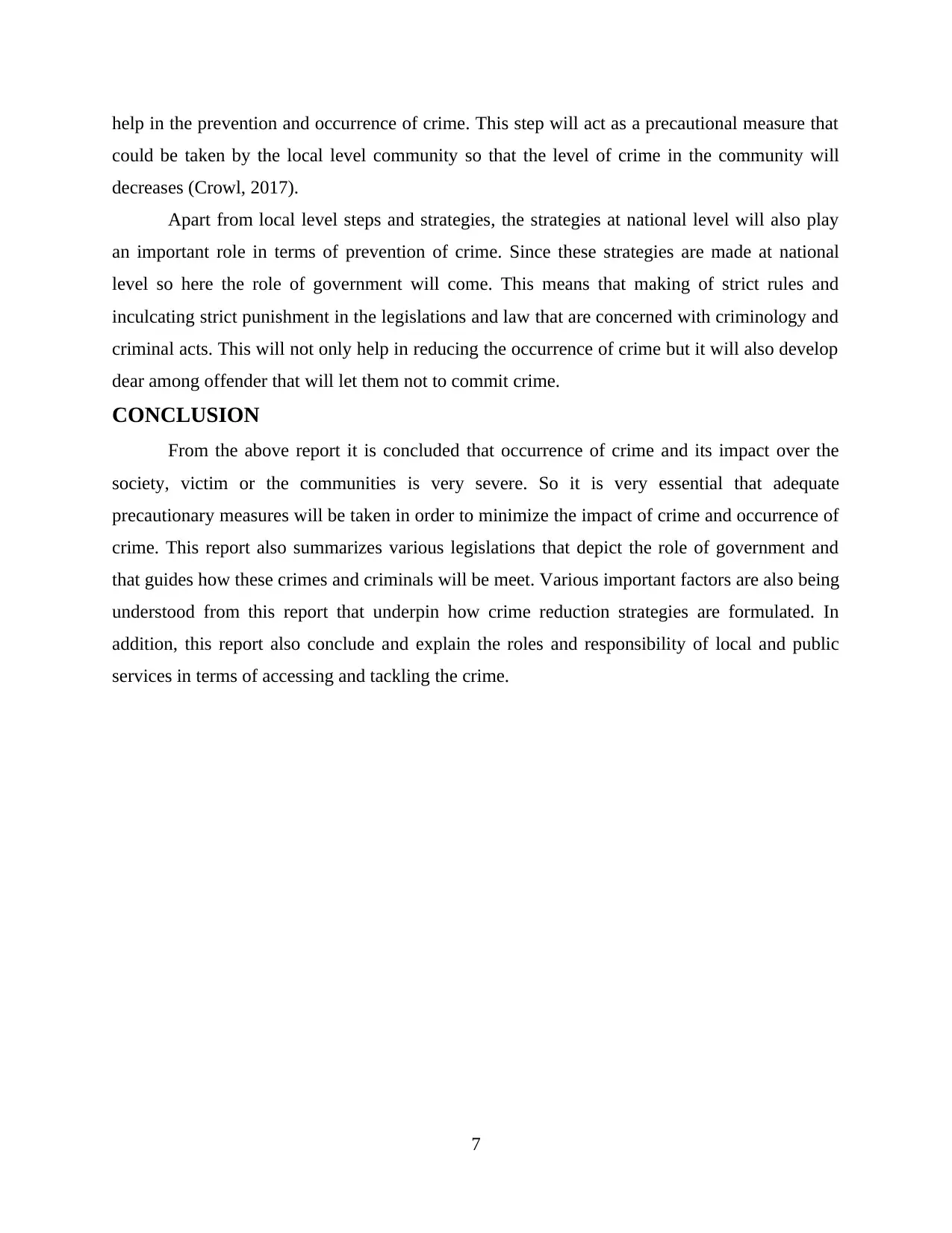
help in the prevention and occurrence of crime. This step will act as a precautional measure that
could be taken by the local level community so that the level of crime in the community will
decreases (Crowl, 2017).
Apart from local level steps and strategies, the strategies at national level will also play
an important role in terms of prevention of crime. Since these strategies are made at national
level so here the role of government will come. This means that making of strict rules and
inculcating strict punishment in the legislations and law that are concerned with criminology and
criminal acts. This will not only help in reducing the occurrence of crime but it will also develop
dear among offender that will let them not to commit crime.
CONCLUSION
From the above report it is concluded that occurrence of crime and its impact over the
society, victim or the communities is very severe. So it is very essential that adequate
precautionary measures will be taken in order to minimize the impact of crime and occurrence of
crime. This report also summarizes various legislations that depict the role of government and
that guides how these crimes and criminals will be meet. Various important factors are also being
understood from this report that underpin how crime reduction strategies are formulated. In
addition, this report also conclude and explain the roles and responsibility of local and public
services in terms of accessing and tackling the crime.
7
could be taken by the local level community so that the level of crime in the community will
decreases (Crowl, 2017).
Apart from local level steps and strategies, the strategies at national level will also play
an important role in terms of prevention of crime. Since these strategies are made at national
level so here the role of government will come. This means that making of strict rules and
inculcating strict punishment in the legislations and law that are concerned with criminology and
criminal acts. This will not only help in reducing the occurrence of crime but it will also develop
dear among offender that will let them not to commit crime.
CONCLUSION
From the above report it is concluded that occurrence of crime and its impact over the
society, victim or the communities is very severe. So it is very essential that adequate
precautionary measures will be taken in order to minimize the impact of crime and occurrence of
crime. This report also summarizes various legislations that depict the role of government and
that guides how these crimes and criminals will be meet. Various important factors are also being
understood from this report that underpin how crime reduction strategies are formulated. In
addition, this report also conclude and explain the roles and responsibility of local and public
services in terms of accessing and tackling the crime.
7
⊘ This is a preview!⊘
Do you want full access?
Subscribe today to unlock all pages.

Trusted by 1+ million students worldwide
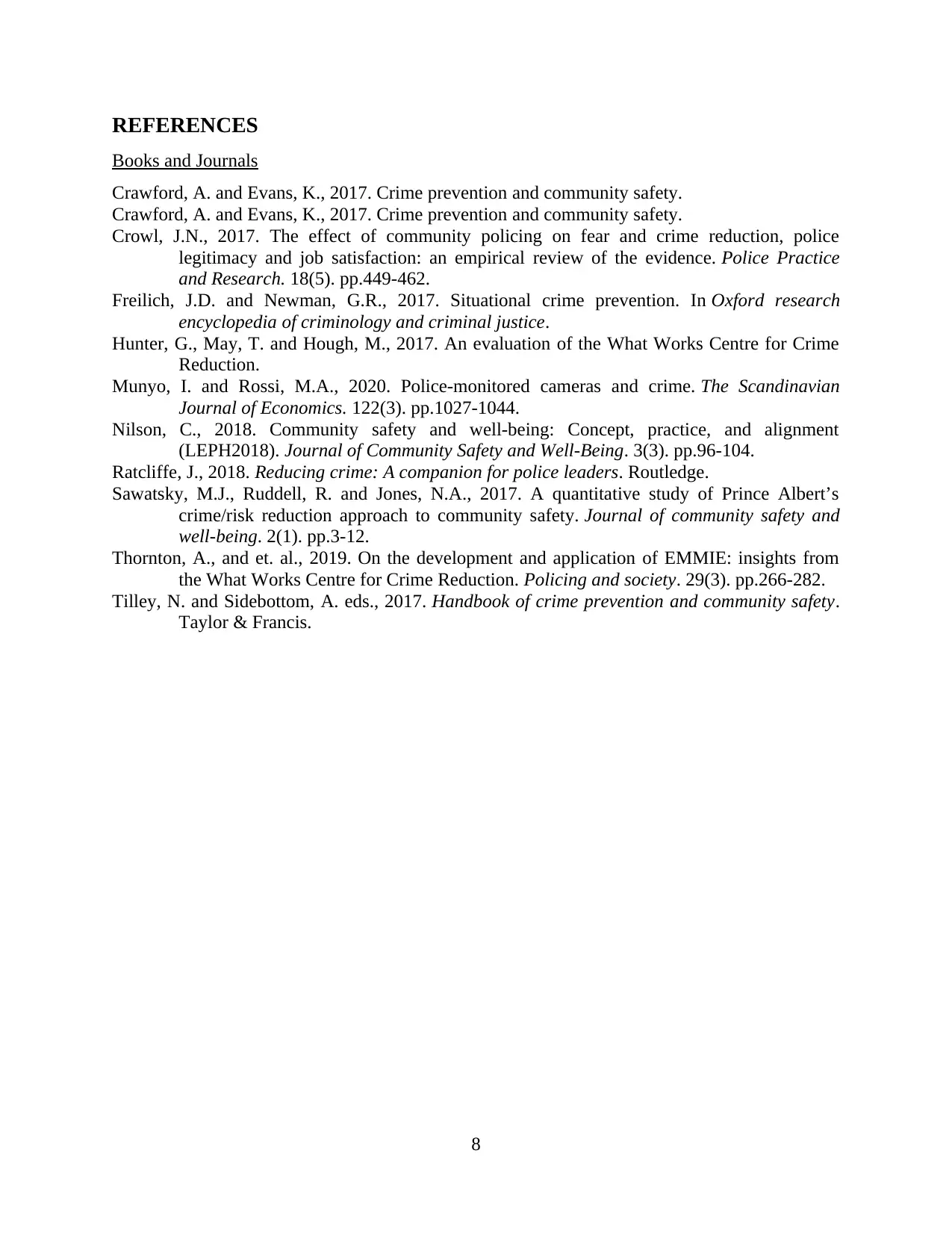
REFERENCES
Books and Journals
Crawford, A. and Evans, K., 2017. Crime prevention and community safety.
Crawford, A. and Evans, K., 2017. Crime prevention and community safety.
Crowl, J.N., 2017. The effect of community policing on fear and crime reduction, police
legitimacy and job satisfaction: an empirical review of the evidence. Police Practice
and Research. 18(5). pp.449-462.
Freilich, J.D. and Newman, G.R., 2017. Situational crime prevention. In Oxford research
encyclopedia of criminology and criminal justice.
Hunter, G., May, T. and Hough, M., 2017. An evaluation of the What Works Centre for Crime
Reduction.
Munyo, I. and Rossi, M.A., 2020. Police‐monitored cameras and crime. The Scandinavian
Journal of Economics. 122(3). pp.1027-1044.
Nilson, C., 2018. Community safety and well-being: Concept, practice, and alignment
(LEPH2018). Journal of Community Safety and Well-Being. 3(3). pp.96-104.
Ratcliffe, J., 2018. Reducing crime: A companion for police leaders. Routledge.
Sawatsky, M.J., Ruddell, R. and Jones, N.A., 2017. A quantitative study of Prince Albert’s
crime/risk reduction approach to community safety. Journal of community safety and
well-being. 2(1). pp.3-12.
Thornton, A., and et. al., 2019. On the development and application of EMMIE: insights from
the What Works Centre for Crime Reduction. Policing and society. 29(3). pp.266-282.
Tilley, N. and Sidebottom, A. eds., 2017. Handbook of crime prevention and community safety.
Taylor & Francis.
8
Books and Journals
Crawford, A. and Evans, K., 2017. Crime prevention and community safety.
Crawford, A. and Evans, K., 2017. Crime prevention and community safety.
Crowl, J.N., 2017. The effect of community policing on fear and crime reduction, police
legitimacy and job satisfaction: an empirical review of the evidence. Police Practice
and Research. 18(5). pp.449-462.
Freilich, J.D. and Newman, G.R., 2017. Situational crime prevention. In Oxford research
encyclopedia of criminology and criminal justice.
Hunter, G., May, T. and Hough, M., 2017. An evaluation of the What Works Centre for Crime
Reduction.
Munyo, I. and Rossi, M.A., 2020. Police‐monitored cameras and crime. The Scandinavian
Journal of Economics. 122(3). pp.1027-1044.
Nilson, C., 2018. Community safety and well-being: Concept, practice, and alignment
(LEPH2018). Journal of Community Safety and Well-Being. 3(3). pp.96-104.
Ratcliffe, J., 2018. Reducing crime: A companion for police leaders. Routledge.
Sawatsky, M.J., Ruddell, R. and Jones, N.A., 2017. A quantitative study of Prince Albert’s
crime/risk reduction approach to community safety. Journal of community safety and
well-being. 2(1). pp.3-12.
Thornton, A., and et. al., 2019. On the development and application of EMMIE: insights from
the What Works Centre for Crime Reduction. Policing and society. 29(3). pp.266-282.
Tilley, N. and Sidebottom, A. eds., 2017. Handbook of crime prevention and community safety.
Taylor & Francis.
8
1 out of 10
Related Documents
Your All-in-One AI-Powered Toolkit for Academic Success.
+13062052269
info@desklib.com
Available 24*7 on WhatsApp / Email
![[object Object]](/_next/static/media/star-bottom.7253800d.svg)
Unlock your academic potential
Copyright © 2020–2025 A2Z Services. All Rights Reserved. Developed and managed by ZUCOL.





